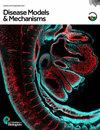牛磺酸能激活 AKT-mTOR 轴,从而恢复类固醇肌病人体 3D 体外模型的肌肉质量和收缩力。
IF 4
3区 医学
Q2 CELL BIOLOGY
引用次数: 1
摘要
类固醇性肌病是一种具有临床挑战性的疾病,因长期使用皮质类固醇或肾上腺肿瘤而加重。在这项研究中,我们设计了一种功能性三维(3D)体外骨骼肌模型来研究类固醇性肌病。通过让生物工程肌肉组织接受地塞米松治疗,我们再现了这种疾病的分子和功能方面。地塞米松导致肌力和肌管直径大幅下降,并诱发疲劳。我们在模型中观察到糖皮质激素受体(GCR)的核转位和泛素-蛋白酶体系统的激活,这表明它们在肌肉萎缩中起着协调作用。然后,我们研究了牛磺酸在类固醇肌病三维模型中的治疗潜力。我们的研究结果表明,牛磺酸能上调磷酸化 AKT,有效对抗泛素-蛋白酶体途径的过度激活。重要的是,我们证明停止皮质类固醇治疗不足以恢复肌肉质量和功能。牛磺酸治疗与皮质类固醇治疗同时进行时,可通过上调 AKT-mTOR 轴,显著增强收缩强度和蛋白质周转。我们的模型不仅确定了一个很有前景的治疗靶点,而且还提出了组合治疗方法,可使接受皮质类固醇治疗或确诊为肾上腺肿瘤的患者受益。本文章由计算机程序翻译,如有差异,请以英文原文为准。
Taurine activates the AKT-mTOR axis to restore muscle mass and contractile strength in human 3D in vitro models of steroid myopathy.
Steroid myopathy is a clinically challenging condition exacerbated by prolonged corticosteroid use or adrenal tumors. In this study, we engineered a functional three-dimensional (3D) in vitro skeletal muscle model to investigate steroid myopathy. By subjecting our bioengineered muscle tissues to dexamethasone treatment, we reproduced the molecular and functional aspects of this disease. Dexamethasone caused a substantial reduction in muscle force, myotube diameter and induced fatigue. We observed nuclear translocation of the glucocorticoid receptor (GCR) and activation of the ubiquitin-proteasome system within our model, suggesting their coordinated role in muscle atrophy. We then examined the therapeutic potential of taurine in our 3D model for steroid myopathy. Our findings revealed an upregulation of phosphorylated AKT by taurine, effectively countering the hyperactivation of the ubiquitin-proteasomal pathway. Importantly, we demonstrate that discontinuing corticosteroid treatment was insufficient to restore muscle mass and function. Taurine treatment, when administered concurrently with corticosteroids, notably enhanced contractile strength and protein turnover by upregulating the AKT-mTOR axis. Our model not only identifies a promising therapeutic target, but also suggests combinatorial treatment that may benefit individuals undergoing corticosteroid treatment or those diagnosed with adrenal tumors.
求助全文
通过发布文献求助,成功后即可免费获取论文全文。
去求助
来源期刊

Disease Models & Mechanisms
医学-病理学
CiteScore
6.60
自引率
7.00%
发文量
203
审稿时长
6-12 weeks
期刊介绍:
Disease Models & Mechanisms (DMM) is an online Open Access journal focusing on the use of model systems to better understand, diagnose and treat human disease.
 求助内容:
求助内容: 应助结果提醒方式:
应助结果提醒方式:


